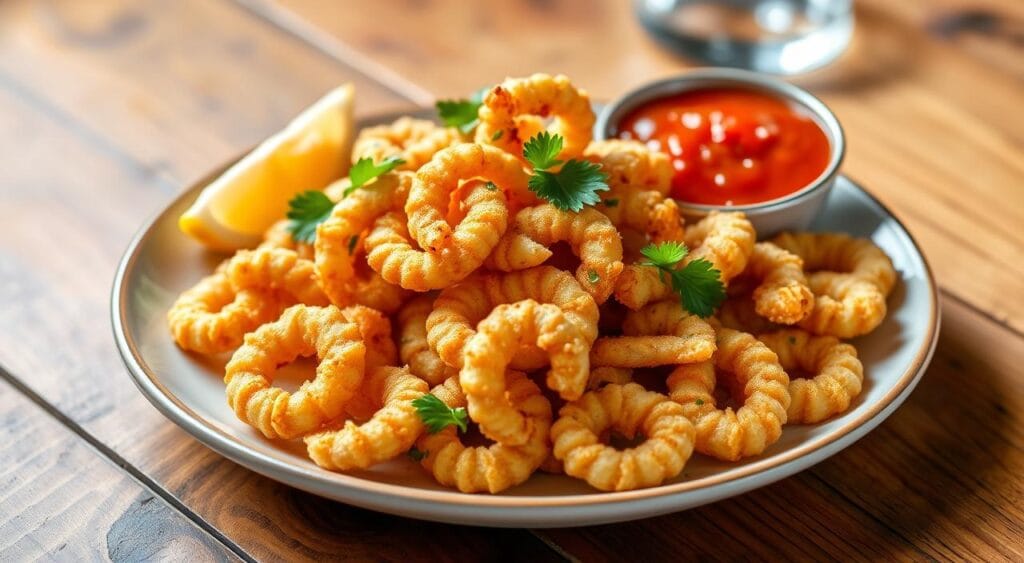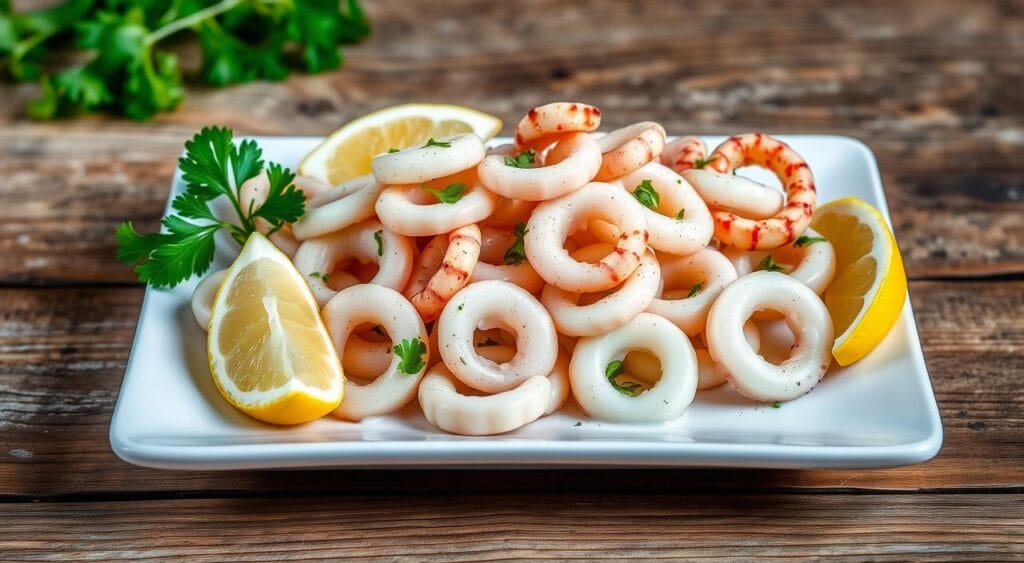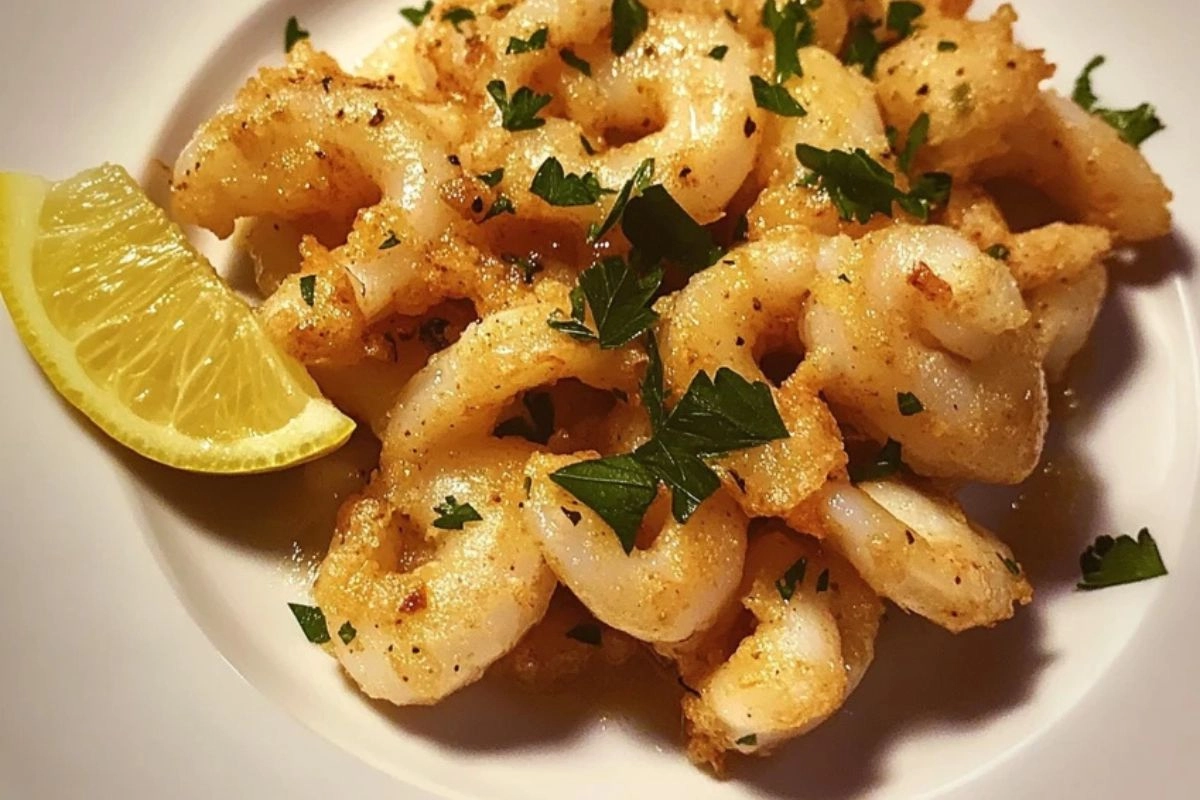Calamari is the term for squid, a slightly sweet, neutral-tasting seafood. It’s often found in “fried calamari,” made from squid rings, breaded, and fried. You can also sauté or grill calamari. The name comes from the Italian “calamaro,” meaning squid, tracing back to Latin.
While it’s seafood, calamari isn’t a fish but a mollusk. There are over 300 squid species. In North America, the California market, longfin inshore, and shortfin squid are the most used.
Key Takeaways
- Calamari is the culinary term for squid, a slightly sweet, neutral-tasting seafood.
- The most popular types of squid used for calamari in North America are the California market squid, longfin inshore squid, and shortfin squid.
- Calamari is often associated with the fried calamari dish, where the squid’s body and tentacles are cut into rings, breaded, and deep-fried.
- Calamari has a firm, chewy texture and a neutral to slightly sweet taste, taking on the flavors of the ingredients it is cooked with.
- Calamari can be purchased fresh or frozen, and is a versatile protein that can be used in a wide range of dishes.
Ingredients (or Main Points)
At the heart of a delicious fried calamari dish is the humble squid. These marine creatures have a firm, slightly chewy texture and a neutral to subtly sweet flavor. They are the perfect base for tasty preparations. When cooked right, the calamari rings should be tender, not rubbery, with a light, crispy exterior.
Squid: The Seafood Superstar
To make the iconic fried calamari, the squid’s body is sliced crosswise. This is the most common way to prepare this seafood delicacy. The calamari rings soak up the flavors of the breading or batter, becoming a protein-packed treat.
Breading or Batter: The Crispy Coating
To get the signature golden-brown crunch, the calamari is dipped in a mix of flour, herbs, and spices before frying in vegetable oil. This method creates a light, crispy exterior that matches the tender, slightly sweet inside of the calamari.

“When cooked properly, fried calamari should be a delightful balance of textures and flavors.”
Instructions/Process/Steps
Before you start cooking calamari, make sure to clean and prepare it well. First, separate the tentacles from the body. Then, peel off the outer skin and rinse the calamari under cold water. This removes any grit or sand.
Next, slice the body into uniform rings. Keep the tentacles intact for a nice presentation. This way, the calamari cooks evenly and stays tender.
Step 1: Separate and Peel
- Separate the tentacles from the calamari body.
- Peel off the outer skin of the calamari body.
- Rinse the calamari under cold water to remove any sand or grit.
Step 2: Slice and Prepare
- Slice the calamari body into uniform rings.
- Leave the tentacles intact for cooking.
- Pat the calamari dry with paper towels to remove excess moisture.

Serving Suggestions
- Serve fried calamari hot, straight from the fryer, for the best texture and flavor.
- Consider pairing fried calamari with other seafood dishes or light sides to create a well-balanced meal.
Storage and Reheating
Storing and handling calamari right is key for the best taste and quality. Fresh calamari should be kept in the fridge and used within a couple of days. Cooked calamari can stay in the fridge for a few days, but it’s best eaten right after frying.
Uncooked calamari can be frozen for months, making it a great seafood choice.
Benefits/Advantages
Calamari is a top choice for seafood lovers. It’s full of protein, omega-3 fatty acids, and minerals like selenium and copper. This makes it a nutrient-dense treat. Plus, it’s low in mercury, so it’s safe and healthy to eat.
Calamari is a great source of protein, with 15.6 grams per 100 grams. It’s perfect for those looking to eat more protein. It also has omega-3 fatty acids, which are good for your heart and brain.
Calamari is also a big source of choline. Only 10% of Americans get enough of this important nutrient. Choline helps with brain health and the immune system.
Calamari is also rich in selenium and copper. A 100-gram serving gives you 64% and 95% of what you need each day. These minerals boost your immune system and help your blood cells work better.
Even though calamari has cholesterol, it doesn’t raise blood cholesterol much. Eating it in moderation is best. You can enjoy calamari as part of a healthy diet.
In short, calamari is a versatile and nutrient-dense seafood choice. It’s packed with health benefits, making it a tasty and nutritious option for your meals.
Variations/Alternatives
Fried calamari is a classic favorite, but there are many other ways to enjoy it. In the Mediterranean, calamari is a key ingredient in paella, risotto, soups, and pasta. In Asia, it’s often grilled or used in tasty stir-fry and noodle dishes.
Looking for something different? Calamari can be sautéed or braised in rich sauces and broths. This makes for satisfying seafood dishes. It fits well in stews and pasta meals too.
Do you love fried calamari or prefer other cooking methods? Either way, there’s a world of flavors to explore. Try different recipes to find your favorite way to enjoy calamari.
“Calamari is a canvas for culinary creativity, allowing chefs and home cooks alike to explore a wide range of flavors and preparations.”
Common Mistakes to Avoid
Cooking calamari can be a fun experience, but there are common mistakes to watch out for. These mistakes can make the calamari overcooked, rubbery, and tough. One big mistake is overcooking the calamari. It should be cooked quickly over high heat to stay tender and slightly chewy. If it’s cooked too long, it turns rubbery and tough.
The batter or breading should be crisp and golden brown. A bad coating can ruin the dish’s texture and taste. It’s important to get the right balance between a crunchy outside and a tender inside.
- Avoid overcooking: Cook calamari quickly over high heat to maintain its tender, slightly chewy texture.
- Ensure the batter or breading is crisp and golden brown: A soggy or heavy coating can compromise the dish’s texture and flavor.
“The key to perfect calamari is to cook it quickly over high heat. Overcooking will result in a rubbery, tough texture that no one wants to eat.” – Chef Gordon Ramsay
By avoiding these common mistakes and using the right cooking techniques, you can make a delicious calamari dish. This dish will highlight the natural sweetness and tender texture of this versatile seafood.
FAQ
What is calamari?
Calamari is the term for squid in cooking. It’s a seafood that tastes slightly sweet and neutral. It’s often used in “fried calamari,” where squid rings are breaded and fried.
What are the common types of squid used for calamari?
In North America, people often use California market squid, longfin inshore squid, and shortfin squid for calamari.
How should calamari be stored and used?
Keep fresh calamari in the fridge for a couple of days. Cooked calamari can be stored for a few days in the fridge. It’s best eaten right after frying. You can also freeze uncooked calamari for months.
What are the health benefits of calamari?
Calamari is very nutritious. It’s high in protein, omega-3 fatty acids, and minerals like selenium and copper.
How else can calamari be prepared?
Calamari can be sautéed, grilled, or added to dishes like paella, risotto, soups, and pasta. It’s not just fried.
What advice do culinary experts provide for preparing calamari?
Chef John suggests using a light batter and hot oil for crispy calamari. Julia Child advises to handle calamari gently and avoid overcooking to preserve its delicate texture.

